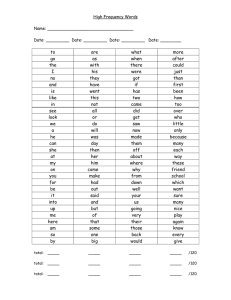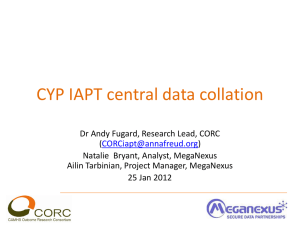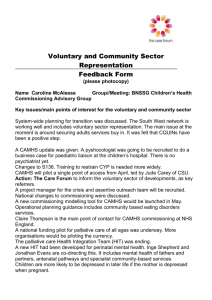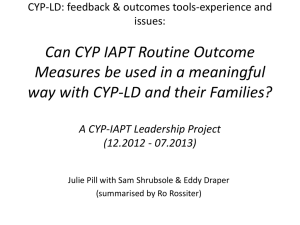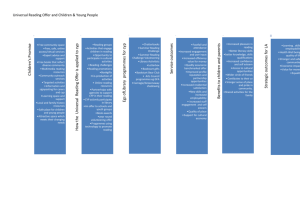Developing a case-mix classification for CAMHS:
advertisement
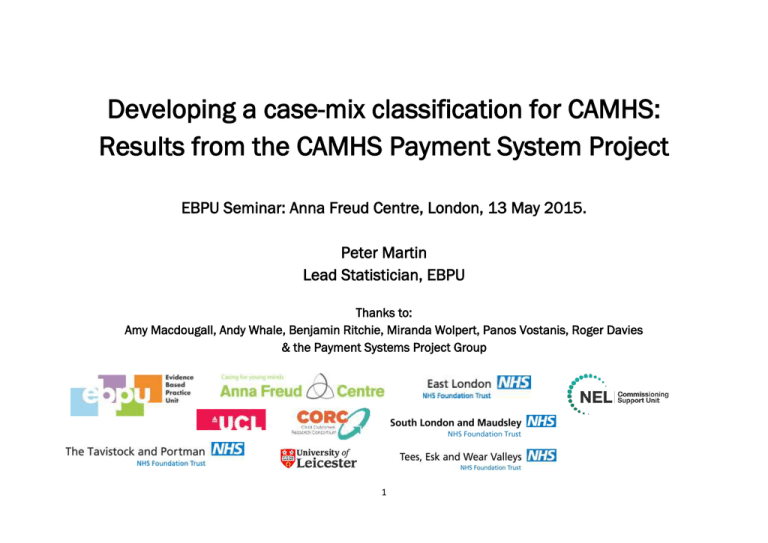
Developing a case-mix classification for CAMHS: Results from the CAMHS Payment System Project EBPU Seminar: Anna Freud Centre, London, 13 May 2015. Peter Martin Lead Statistician, EBPU Thanks to: Amy Macdougall, Andy Whale, Benjamin Ritchie, Miranda Wolpert, Panos Vostanis, Roger Davies & the Payment Systems Project Group 1 Why am I here? To present results from the CAMHS Payment System Project: Groupings and how they were developed Can data teach us something about CAMHS? Context: Underfunding of CAMHS Lack of comparable data on outcomes, treatment activity, and problem description across services 2 CAMHS Payment System Project 2012-2015. Commissioned by the Department of Health, but transferred to NHS England in 2014 Main aim: to develop “clusters” for CAMHS. A classification should satisfy the following quality criteria: o clinical meaningfulness o ability to identify instances or periods of care (or advice/help) of similar resource use, reflecting service user need o reliability of identification. A system for grouping health service users is called a “case-mix classification”. 3 Approach and Sources of Information 4 Data Collection and Description Data collected from 20 CAMHS services: Sep 2012 through June 2014 Focus on working with services to achieve high data quality Analysis Sample: 4,573 closed or dormant “periods of contact” from 11 services (for analyses predicting resource use) Full Sample: 11,353 open, closed or dormant “periods of contact” from the same 11 services Community CAMHS only 5 Current View Tool: Problem Description 6 Current View Tool: Complexity Factors, Contextual Problems, and EET Issues 7 Note: N = 4573. 40 periods of contact were recorded to have attended more than 30 appointments. These are not shown in this graph, but are included in the analysis. 8 Insights from Data Analysis: Appointments Around a quarter of children and young people (CYP) presenting at CAMHS attend a single appointment before the case is closed. Around half of CYP attend three sessions or fewer. Around 5 % of CYP attend thirty appointments or more. These 5 % account for about a third of all appointments that happen in CAMHS. Source: CORC data submitted 2012/13. 9 Note: N = 4573. 10 Note: N = 4573. For the purpose of this graph, multiple Anxieties were counted as if they constituted a single problem. 11 Note: N = 4573. For the purpose of this graph, multiple Anxieties were counted as if they constituted a single problem. 12 Note: N = 4573. 13 Number of Complexity Factors Note: N = 4573. 14 Note: N = 4573. 15 Number of Contextual and EET Issues rated moderate or severe Note: N = 4573. 16 Insights from data analysis (1) Presenting Problems Around a quarter of CYP appear to present with mild problems only (from Current View Ratings) About half of all CYP present with “multiple difficulties”: i.e. have more than one problem rated at least ‘moderate’ Family Relationship Difficulties, Low Mood/Depression, and Peer Relationship Difficulties are the three difficulties most frequently rated as present. Complexity Factors About 45 % of CYP were rated to have one or more complexity factors at case opening About 20 % of CYP were rated to have two or more complexity factors 17 Insights from data analysis (2) Contextual Problems, EET Issues Around half of CYP had one or more contextual problem or EET issue rated as moderate or severe Around a quarter of CYP had two or more such issues rated as moderate or severe 18 What does “clustering” (“grouping”) mean? Note: These images represent simulated illustrations only. No CAMHS data were used to make them. 19 Development of a case-mix classification Approach 1: Supervised Cluster Analysis (Andy Whale & PM) Method: Regression Trees This resulted in models that were unreliable (different random subsamples of the data yielded different models) Approach 2: Unsupervised Cluster Analysis (Amy Macdougall & PM) Method: k-medoid cluster analysis This resulted in an ill-fitting classification, and a poor prediction of resource use Approach 3: Conceptually guided clustering using NICE guidance categories This resulted in the best prediction of resource use overall Different classifications were compared (3 clusters, 5 clusters, 16 clusters, 18 clusters) Model Comparison using statistical criteria (AIC / BIC) 20 Group Development (Approach 3 from previous slide) The development of groups was informed by two principles: The THRIVE model for CAMHS NICE guidance Philosophy: Assignment of a CYP to a group should be made by the clinician after a collaborative decision on treatment or advice has been made. 21 THRIVE The THRIVE Model inspired a broad distinction between three categories of service users: “Getting Advice”: CYP thought to benefit from signposting, advice on selfmanagement, or assessment “Getting Help”: CYP who are thought to benefit from goals-focused, evidenceinformed, outcomes-oriented intervention “Getting More Help”: CYP who are thought to benefit from extensive treatment 22 Classification of CYP into NICE Guidance Categories We identified 14 types of presenting problems for which NICE clinical guidelines were available: ADHD Autism Assessment Autism Management Bipolar Disorder Conduct Disorder Depression Eating Disorder Emerging Borderline Personality Disorder Generalized Anxiety Disorder or Panic Disorder Obsessive-Compulsive Disorder Psychosis PTSD Self Harm Social Anxiety 23 Algorithm for Group Allocation Information from CAMHS practitioners’ Current View ratings at first contact was used to check, for each case, whether presenting problems appeared to ‘fit’ a NICE clinical guideline. To ‘fit’ a NICE guideline, a CYP had to fulfil the following criteria: Have the “index problem” defined by the NICE guideline, rated ‘moderate’ or ‘severe’ Not have a significant “comorbidity” that would mean that NICE guideline may not be applicable in a straightforward way Example: To be classified into the category “OCD”, a CYP had to: Have “Compelled to do or think things” rated moderate or severe (this is the “index problem”) Not have any of 23 specific other problems (e.g. “Low Mood”, “Delusional Beliefs or Hallucinations”, etc.) rated at equal or higher severity compared to the index problem 24 Algorithm for Group Allocation (2) If, after applying the rules explained on the previous slide, the CYP could not be allocated to a group, they were assigned in one of five additional groups (on which see below), according to clear rules. In practice, the algorithm is intended to be an aid in grouping only. The clinician should always be able to override the algorithm’s suggested group allocation. We did not develop an algorithm for “Emerging Borderline Personality Disorder”, because we judged that this is rarely identifiable at first contact. 25 26 Groupings: Overview We propose to group children seen in CAMHS into 19 groups. 14 groups are defined with reference to a NICE guideline; their names reference diagnostic categories, but a formal diagnosis is not required for a CYP to belong to one of these groups 2 groups are defined by the presence of specific types of co-occurring difficulties: o Getting Help with Co-occurring Behavioural and Emotional Difficulties o Getting Help with Co-occurring Emotional Difficulties 3 groups are not symptom specific, but are distinguished by the type of agreed treatment: o Getting Advice: Signposting and Self-management Advice o Getting Help with [other] Difficulty or Difficulties o Getting More Help with Co-occurring Difficulties of Severe Impact 27 Estimated percentages of grouping membership Short Estimated Label percent ADV 27.70 % NEU 3.47 % ADH 6.96 % AUT 2.16 % BIP 1.03 % BEH 5.18 % DEP 5.76 % GAP 4.22 % OCD 1.11 % PTS 1.74 % SHA 5.68 % SOC 1.59 % BEM 1.69 % EMO 7.65 % COD 16.08 % EAT 1.76 % PSY 1.24 % CSI 8.43 % Group Getting Advice: Signposting / Self-management Getting Advice: Neurodevelopmental Assessment ADHD Autism Spectrum Bipolar Disorder Antisocial Behaviour, Conduct Disorders Depression GAD and/or Panic Disorder OCD PTSD Self-harm Social Anxiety Disorder Co-occurring Behavioural And Emotional Difficulties Co-occurring Emotional Difficulties Other Difficulty/ Co-occurring Difficulties Eating Disorders Psychosis Co-occurring Difficulties of Severe Impact 28 Notes: n = 11,353. The group ‘Neurodevelopmental Assessment’ is not mutually exclusive with the remaining seventeen groups. Thus percentages sum to 100 %, not counting ‘NEU’. The grouping ‘Symptoms/Presentation Suggestive of High Risk of Emerging Borderline Personality Disorder or Potential BPD’ is not represented, since there is currently no allocation algorithm for this group. Percentage of Group Membership by Age Band Note: Total n = 10,172. There were 1180 children in the Full Sample who had no information on age and are excluded from this table. Error bars show 95 % confidence intervals. See also notes to previous slide. 29 Number of Appointments by Group Notes: N = 4573. For notes on groups not shown see slide 23. 30 What about Complexity? Estimated membership proportions: Behavioural and Emotional Difficulties: ~ 2% Co-occurring emotional difficulties: ~ 8% Other (co-occurring difficulties): ~16 % Co-occurring difficulties with severe impact: ~ 8 % We estimate that around a third of children present with significant co-occurring problems, which may mean that no single NICE guidance is in itself sufficient to inform treatment. But what about complexity factors, contextual problems, and EET issues? 31 Testing the relevance of complexity factors (etc.) for predicting resource use 32 Notes to previous slide: The plot on the previous slide is based on a model predicting the “number of appointments” using 18 groupings and 19 complexity, context and EET factors as predictors. Coloured bars show estimates of the effect of having the associated risk factor, compared to the risk factor being absent. A bar reaching ‘up’ indicates that the associated risk factor is predicted to increase the number of appointments; a bar reaching ‘down' indicates that the associated risk factor is predicted to decrease the number of appointments. Error bars around the coloured bars show 95 % confidence intervals. If error bars span the value “0”, then there is no strong evidence for the influence of the associated risk factor. See below for a legend to labels, and for the model specification. The estimated effects of the 18 clusters are shown alongside the effects for complexity, context and EET factors. Factors are distinguished by colour: beige bars show complexity, contextual, or EET effects; blue bars show groups belonging to “Getting Help”, purple bars show groups belonging to “Getting More Help”. The influence of each cluster or risk factor is shown compared to a child in the “Getting Advice: Signposting and Self-management” group without any risk factors. It can be seen that Group Membership is a more important predictor of “number of appointments” than any of the associated risk factors. The model used is called a mixed effects negative binomial regression; it includes a random effect for the service the CYP attended (effect not shown). A full model specification is given at the end of these slides. 33 Legend to Slide 32 Complexity Factors ABU: Experience of Abuse or Neglect CIN: Child in Need FIN: Living in financial difficulty JUS: Contact with Youth Justice System LAC: Looked after Child LD: Learning Disability NEI: Neurological Issues PAR: Parental Health Issues PHY: Physical Health Problems PRO: Current Protection Plan REF: Refugee or asylum seeker WAR: Experience of War, Torture or Trafficking YC: Young Carer Contextual Problems ENG: Service Engagement COM: Community Issues HOM: Home SCL: School, Work or Training Education/Employment/Training ATA: Attainment Difficulties ATE: Attendance Difficulties Groupings: Getting Advice ADV: Getting Advice: signposting/self-management NEU: Neurodevelopmental Assessment Groupings: Getting Help ADH: ADHD AUT: Autism BIP: Bipolar Disorder (moderate) BEH: Antisocial Behaviour / Conduct Problems DEP: Depression GAP: Generalized Anxiety or Panic Disorder OCD: Obsessive Compulsive Disorder PAN: Panics PTS: PTSD SHA: Self Harm SOC: Social Anxiety BEM: Behavioural and Emotional Difficulties EMO: Co-occuring Emotional Difficulties COD: Other (co-occurring) Difficulties Groupings: Getting More Help EAT: Eating Disorder PSY: Psychosis CSI: Co-occurring difficulties of severe impact 34 Summary The classification of CAMHS cases according to our designed groupings provides a better and more reliable prediction of resource use than “a-theoretical” models found by statistical methods (cluster analysis, regression trees). Once group membership was taken into account, there was no strong evidence of an additional contribution by context and complexity factors to the prediction of resource use. 35 Summary: Estimated Grouping Proportions Proportions by “Super Grouping” give an impression of the frequency with which different types of need are encountered in CAMHS: Getting Advice: 28 % Getting Help: 61 % Getting More Help: 11 % Proportions shown by “NICE-relevance” indicate an aspect of the diversity and complexity of CYP seen in CAMHS: Groups defined by NICE guidance: 39 % Groups defined by specific “Comorbidities”: 9 % “Other” Groups: 52 % 36 Quality criteria Clinical meaningfulness: The classification relates to NICE best practice guidelines, and takes into account frequent “comorbidities” and distinguishes groups of CYP that don’t appear to neatly fit into a category. We recommend that allocation to a group is based on a shared decision about treatment aims. Relation to resource use: Modest relationship to resource use (but better than purely ‘data’ driven models). Reliability of identification: Unclear. Reliability will depend on reliability of Current View Ratings, as well as reliability of practitioners’ group allocation decisions (when overriding the algorithm’s suggestion). 37 Clinical Meaningfulness? Hypothetical case studies of group allocation based on shared treatment decision Hypothetical Case 1: “Algorithm suggests ‘Getting Help: With Co-occurring Emotional Difficulties’ (H22) on the basis of ‘Compelled to do or think things (OCD)’ and ‘Depression/low mood (Depression)’ rated as ‘moderate’ on the Current View tool. Young person and clinician believe that the depression arose after the OCD had seriously limited ability to get on with life. They think a care package focussed on helping with the compulsion to do things would be more appropriate than a care package aimed at helping with both compulsion to do things and depression, as it is felt that treatment for the former would help to lift depression. Thus ‘Getting Help: Guided by NICE Guideline 31 (OCD)’ (H4) is chosen.” Hypothetical Case 2: “Algorithm suggests ‘Getting Help: Guided by NICE Guideline 26 (PTSD)’ (H2) on the basis of ‘Disturbed by traumatic event (PTSD)’ rated as ‘moderate’ on the Current View tool. Discussion with young person regarding treatment options and recommendation that seen for weekly sessions to process trauma. Young person chooses not to access treatment as now understands symptoms, is able to manage these and does not wish to face difficult trauma memories at present. Symptom management strategies agreed between clinician, young person and their family. Bibliotherapy with one-off follow up is offered. Thus ‘Getting Advice: Signposting and Self-management Advice’ (A1) is chosen.” 38 Conclusions Application: Our idea is that grouping allocation should be made by the clinician based on a shared decision between the clinician and a child or young person (and their family) regarding the aim of advice or treatment Algorithm: The algorithm which ‘predicts’ membership in a specific group is intended as an aid to decision making; the algorithm may always be overruled by the clinician What’s next: We recommend further investigations to establish (and, if necessary, improve) the reliability and validity of the groupings, and to gauge training needs for CAMHS staff involved in using the groupings 39 Appendix: Model Specification for Slide 32 A mixed-effects negative binomial regression approach was used to explore the effect of contextual problems and complexity factors. The model includes a random effect for “CAMH service” in order to take into account the nested data structure. 𝑝 log(𝜇𝑖𝑗 ) = 𝛽0 + ∑𝑘=1 𝛽𝑘 𝑥𝑖𝑗𝑘 + 𝑢𝑖 , where: Yij ~ NB(μij, α) is the number of appointments after the first session (so that the minimum number is zero) for the jth child treated by the ith service, with mean μij and dispersion parameter α; β0 is an intercept term; βk, k = 1, … , p, is a vector of slope coefficients corresponding to the p predictor variables x1, …, xp; ui ~ N(0, σu 2 ) is the random intercept term for the ith service, i = 1, …, 11; The variance function is defined as: V(α) = μ + αμ2 . (This is called the “NB2 parameterization”.) 40

